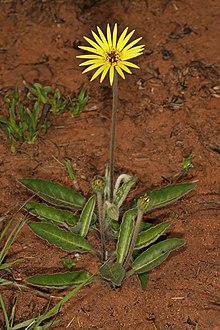Gerbera ambigua
| Gerbera ambigua | |
|---|---|

| |
| Gerbera ambigua from Vernon Crookes Nature Reserve, KwaZulu-Natal. | |
| Scientific classification | |
| Kingdom: | Plantae |
| Clade: | Tracheophytes |
| Clade: | Angiosperms |
| Clade: | Eudicots |
| Clade: | Asterids |
| Order: | Asterales |
| Family: | Asteraceae |
| Genus: | Gerbera |
| Species: | G. ambigua
|
| Binomial name | |
| Gerbera ambigua Sch.Bip. (1844)
| |
| Synonyms | |
| |
Gerbera ambigua is a species of flowering plant in the section Lasiopus[1] of genus Gerbera belonging to the basal Mutisieae tribe within the large Asteraceae (or Compositae) family.[2]
It is indigenous to Southern Africa and commonly known as the Botterblom or Griekwateebossie in Afrikaans. It was first described by Carl Heinrich "Bipontinus" Schultz in Flora Journal in 1844.[3]

Etymology
[edit]The genus was named in honour of German botanist and medical doctor Traugott Gerber (1710 — 1743).[4] The Latin epithet ambigua means "doubtful".
Description
[edit]
Gerbera ambigua is an acaulescent tufted perennial herb with thickened woody rootstock and naked flowering scapes up to 35 cm high. Leaves are very variable, usually petiolate, elliptical or oblanceolate, 5–8 cm long and 2.5–3.5 cm wide, thinly hairy above and white- or yellow-felted beneath. Flower-heads (capitula) are 2–5 cm in diameter, ray florets are white to yellow abobe and pink to coppery reddish on reverse. It flowers from September to February.[5][6][7]
Distribution
[edit]Gerbera ambigua grows in grassland and savanna of eastern South Africa, Lesotho, Eswatini and in tropical Southern Africa: Zaire, Angola, Zambia, Malawi, Tanzania, Zimbabwe, Mozambique, Malawi.[2]
Habitat
[edit]The species grows from 1500 m to 2600 m above sea level on rocky slopes in woodland. It is able to survive both dry, cold winters and annual fires which are typical of the region in which it is found.[citation needed]
Ecology
[edit]The species is pollinated by many different flying insects including beetles which feed on the pollen.[citation needed]
References
[edit]- ^ Hansen, Hans V. (1988). "A taxonomic revision of the genera Gerbera sect. Isanthus, Leibnitzia (in Asia), and Uechtritzia (Compositae, Mutisieae)". Nordic Journal of Botany. 8 (1): 61–76. doi:10.1111/j.1756-1051.1988.tb01707.x. ISSN 1756-1051.
- ^ a b "Gerbera ambigua Sch.Bip". Plants of the World Online. Royal Botanic Gardens Kew. Retrieved 5 February 2022.
- ^ "Flora oder Allgemeine Botanische Zeitung: welche Recensionen, Abhandlungen, Aufsätze, Neuigkeiten und Nachrichten, die Botanik betreffend, enthält". Flora. Flora, oder, Allgemeine botanische Zeitung. 27. Regensburg: Die Gesellschaft: 780. 7 January 1844.
- ^ "Traugott Gerber". Gerbera.org.
- ^ Pooley, Elsa (2003). Mountain flowers : a field guide to the flora of the Drakensberg and Lesotho (1st ed.). Durban [South Africa]: Flora Publications Trust, c/o Natal Herbarium. p. 114. ISBN 0620302224.
- ^ Manning, John (March 29, 2019). Field guide to wild flowers of South Africa, Lesotho and Swaziland. Cape Town: Struik Nature. p. 406. ISBN 9781770077584.
- ^ Pope, G. V. (1992). "Compositae". Flora Zambesiaca. 6 (1). Retrieved 5 February 2022.
External links
[edit]- Gerbera.org — Official website of the Gerbera Association, established in Barberton.
- Sanbi.org — Website about plants of Southern Africa, established by SA National Biodiversity Institute.
